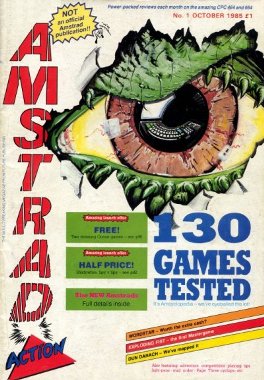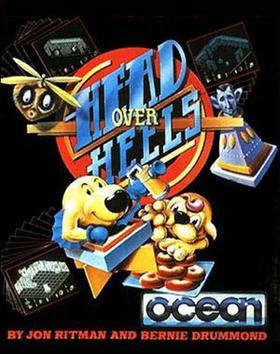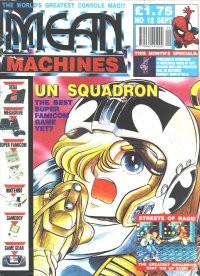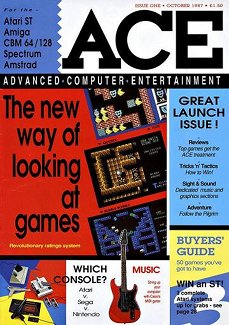
Amstrad Action was a monthly magazine, published in the United Kingdom, which catered to owners of home computers from the Amstrad CPC range and later the GX4000 console.

Rick Dangerous is a platform game developed by Core Design for the Acorn Archimedes, Amiga, Atari ST, Amstrad CPC, ZX Spectrum, Commodore 64, and MS-DOS. The game was released in 1989 and published by MicroProse on the Firebird Software label in the UK, and on the MicroPlay label in America. It was also published in Spain by Erbe Software. Later, it was released with two other games, Stunt Car Racer and MicroProse Soccer, on the Commodore 64 Powerplay 64 cartridge. The game was followed by a sequel, Rick Dangerous 2, in 1990. Loosely based on the Indiana Jones film franchise, the game received mixed reviews from critics.

Your Sinclair, or YS as it was commonly abbreviated, was a commercially published and printed British computer magazine for the Sinclair range of computers, mainly the ZX Spectrum. It was in circulation between 1984 and 1993.

Space Hulk is a 1993 real-time tactical video game for MS-DOS, Amiga and PC-98. The game was based on Games Workshop's 1989 board game of the same name. Set in the fictional Warhammer 40,000 universe, the player directs squads of Space Marines, genetically enhanced armoured soldiers, in their missions to protect the human race from deadly aliens. Space Hulk was developed and published by Electronic Arts, with support from Games Workshop.
Newsfield Publications Ltd was a British magazine publisher during the 1980s and early 1990s.

Barbarian: The Ultimate Warrior is a 1987 video game developed and published by Palace Software for the Amstrad CPC, Commodore 64, and ZX Spectrum. The game was ported to many other systems and was licensed to Epyx who published it as Death Sword in the United States.
1989 saw many sequels and prequels in video games, such as Phantasy Star II, Super Mario Land, Super Monaco GP, along with new titles such as Big Run, Bonk's Adventure, Final Fight, Golden Axe, Strider, Hard Drivin' and Teenage Mutant Ninja Turtles. The year also saw the release of the Sega Genesis and TurboGrafx-16 in North America, and the Game Boy worldwide along with Tetris and Super Mario Land.

The One was a video game magazine in the United Kingdom which covered 16-bit home gaming during the late 1980s and early 1990s. It was first published by EMAP in October 1988 and initially covered computer games aimed at the Atari ST, Amiga, and IBM PC compatible markets.

Zero was a video game magazine in the UK, published monthly by Dennis Publishing Ltd. between November 1989 and October 1992. It won the InDin Magazine of the Year award in both 1990 and 1991, and was also briefly the best-selling multi-format 16-bit computer magazine in the UK.

Head Over Heels is an action-adventure video game released by Ocean Software in 1987 for several 8-bit home computers. It uses an isometric engine that is similar to the Filmation technique first developed by Ultimate Play the Game.

Dalek Attack is a 1992 computer game based on the long-running British science fiction television series Doctor Who, in which the player controls the Doctor and fights recurring adversaries, the Daleks and other enemies. In most versions of the game, the player can choose between playing as the Fourth, Fifth or Seventh Doctor; in the MS-DOS and Amiga versions, the player can play as the Second, Fourth or Seventh Doctor, and in the ZX Spectrum version only the Seventh Doctor was available. A second player may play as the Doctor's companion. K-9 also makes appearances later in the game as does Davros, creator of the Daleks in the TV series, as the final end of level boss. The game is set in London, Paris, New York, Tokyo and Skaro.

Mean Machines was a multi-format video game magazine published between 1990 and 1992 in the United Kingdom.

ACE was a multi-format computer and video game magazine first published in the United Kingdom by Future Publishing and later acquired by EMAP.

Worms is a 2D artillery tactical video game developed by Team17 and released in 1995. It is the first game in the Worms series of video games. It is a turn based game where a player controls a team of worms against other teams of worms that are controlled by a computer or human opponent. The aim is to use various weapons to kill the worms on the other teams and have the last surviving worm(s).

Blackfish Publishing was a magazine publishing company based in Bath, UK. Its first title was Death Ray, a science fiction and fantasy title.
Death Ray was a British magazine devoted to science fiction and fantasy in all its forms, especially media-related topics and novels. It was published every two months, with the first issue going on sale in May 2007. Typical issues were 132 pages, perfect bound, on glossy paper.

Bomberman is an action-maze video game originally developed and published by Hudson Soft for the PC Engine in Japan on 7 December 1990 and later in North America for the TurboGrafx-16 by NEC in 1991. Belonging to the Bomberman franchise, it is a re-imagining of the first game in the series starring White Bomberman on a quest to rescue Lisa, the kidnapped daughter of his inventor Dr. Mitsumori, from the castle of Black Bomberman while defeating evil monsters and villains that work for him. The game was later ported to home computers, each one featuring changes compared to the original version. Conversions for other platforms were in development but never released. The title garnered positive reception from critics since its initial release on the PC Engine/TurboGrafx-16 and later on home computers.

Space Gun is a 1990 first-person shooter arcade game released by Taito. The game is set aboard a crippled space station that has been overrun by hostile alien creatures. The objective is to rescue human crew members while destroying the alien creatures. The game lets the player shoot limbs off the creatures, resulting in blood splatters.

Fun School is a series of educational packages developed and published in the United Kingdom by Europress Software, initially as Database Educational Software. The original Fun School titles were sold mostly by mail order via off-the-page adverts in the magazines owned by Database Publications. A decision was made to create a new set of programs, call the range Fun School 2, and package them more professionally so they could be sold in computer stores around the UK. Every game comes as a set of three versions, each version set to cater for a specific age range.

P-47: The Phantom Fighter is a 1988 horizontally scrolling shooter arcade video game originally developed by NMK and published by Jaleco. Set during World War II, players control a Republic P-47 Thunderbolt fighter aircraft to face against the Nazis, who are occupying multiple countries around the world. Its gameplay involves destroying waves of enemies, picking up power-ups and new weapons, and destroying bosses. It ran on the Mega System 1 hardware.

















